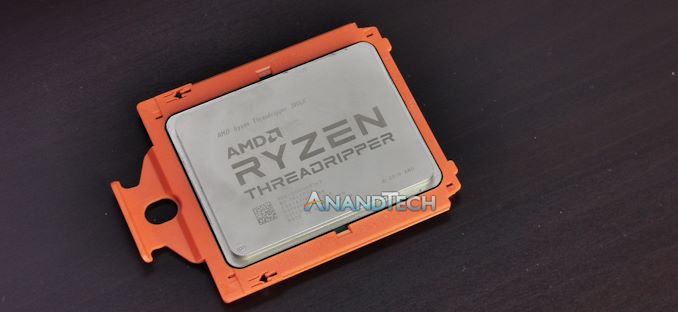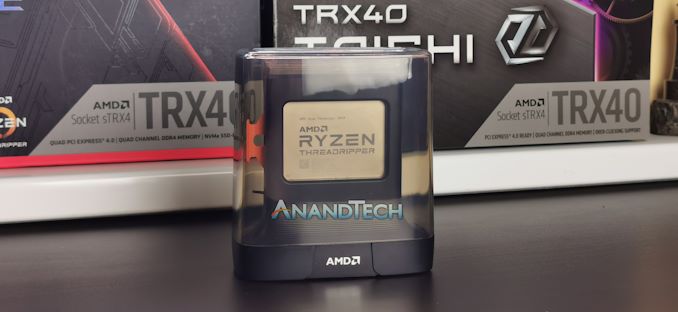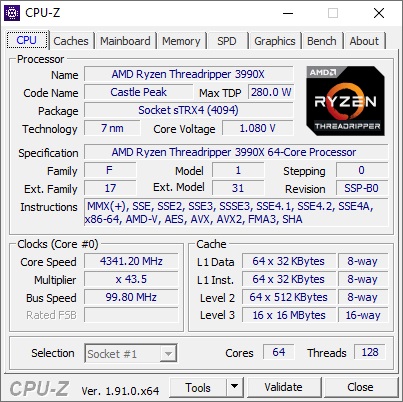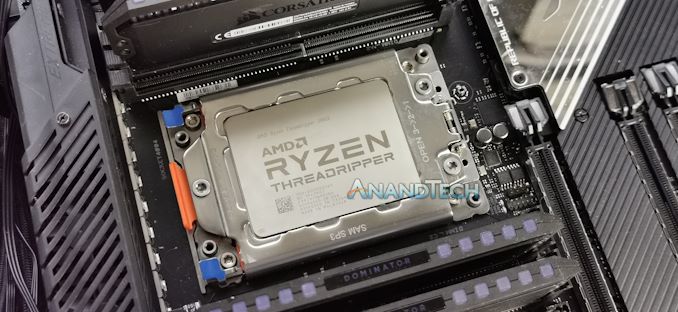The 64 Core Threadripper 3990X CPU Review: In The Midst Of Chaos, AMD Seeks Opportunity
by Dr. Ian Cutress & Gavin Bonshor on February 7, 2020 9:00 AM EST
The recent renaissance of AMD as the performance choice in the high-end x86 market has been great for consumers, enabling a second offering at the top-end of the market. Where Intel offers 28 cores, AMD offers 24 and 32 core parts for the high-end desktop, and to rub salt into the wound, there is now a 64 core offering. This CPU isn’t cheap: the Ryzen Threadripper 3990X costs $3990 at retail, more than any other high-end desktop processor in history, but with it AMD aims to provide the best single socket consumer processor money can buy. We put it through its paces, and while it does obliterate the competition, there are a few issues with having this many cores in a single system.
I Want Performance, What Are My Options
The new AMD Ryzen Threadripper 3990X is a 64 core, 128 thread processor designed for the high-end desktop market. The CPU is a variant of AMD’s Enterprise EPYC processor line, offering more frequency and a higher power budget, but fewer memory channels, fewer PCIe, and a lower memory capacity support. The 3990X is at that cusp between consumer and enterprise based on its features and cost, and it’s ultimately going to compete against both. On paper, users who don’t necessarily need all of the 64 core EPYC features might turn to the 3990X, whereas consumers who need more than 32 cores are going to look here as well. We’re going to test against both.
The TR3990X is part of the Threadripper 3000 family, and will partner its 32 core and 24 core brethren in being paired with new TRX40 motherboards. Despite the same socket as the previous generation Threadrippers, AMD broke motherboard compatibility this time around in order to support PCIe 4.0 from the CPU to the chipset, allowing for higher bandwidth configurations for extra controllers. We’ve covered all 12 of the TRX40 motherboards on the market in our motherboard and chipset overview, with a lot of models focusing on 3x PCIe 4.0 x16 support, multi-gigabit Ethernet onboard, Wi-Fi 6, and one even adding in Thunderbolt 3.

ASUS ROG Zenith II Alpha Motherboard, Built for 3990X
All the Threadripper 3000 family CPUs support a total of 64 PCIe 4.0 lanes from the CPU, and another 24 from the chipset (however each of these use eight lanes to communicate with each other). There are four memory channels, supporting up to DDR4-3200 memory, and each CPU has a rated TDP of 280 W. We’ve tested the 3970X and 3960X when those CPUs were launched – you can read the review here.
| AMD Zen 2 Socketed CPUs | |||||||
| AnandTech | Cores/ Threads |
Base/ Turbo |
L3 | DRAM 1DPC |
PCIe | TDP | SRP |
| Third Generation Threadripper | |||||||
| TR 3990X | 64 / 128 | 2.9 / 4.3 | 256 MB | 4x3200 | 64 | 280 W | $3990 |
| TR 3970X | 32 / 64 | 3.7 / 4.5 | 128 MB | 4x3200 | 64 | 280 W | $1999 |
| TR 3960X | 24 / 48 | 3.8 / 4.5 | 128 MB | 4x3200 | 64 | 280 W | $1399 |
| Ryzen 3000 | |||||||
| Ryzen 9 3950X | 16 / 32 | 3.5 / 4.7 | 64 MB | 2x3200 | 24 | 105 W | $749 |
The new CPU, the 3990X, comes at the hefty price of $1 per 'X' (because it's called the 3990X and costs $3990, get it?). With 64 cores it has a rated base frequency of 2.9 GHz, and a turbo of 4.3 GHz. In our testing, we saw the single core frequency go as high as 4.35 GHz, above the rated turbo, and the all-core turbo around 3.45 GHz.
Who is This CPU Aimed At?
Not everyone needs 64 cores, and AMD has been very clear about this in their messaging. Even though the 3990X is part of AMD’s high-end desktop line, because it’s breaking new ground in core count and price, it sort of goes beyond the high-end, essentially eclipsing the prosumer/server market. This means users (and companies) that can amortize and justify the cost of the hardware as it enables them to complete projects (and therefore contracts) faster. For a user that needs to create something, rather than doing 25 prototypes a week, doing 100 per week makes their workflow a lot more complete, and it’s this sort of user AMD is going after.
Render farms that run on CPU is going to be a key example. AMD has already promoted the fact that several animation and VFX studios that produce effects in blockbuster films have been running engineering samples of the 64-core Threadripper processors for titles already in the market. Then there are video game production houses and architects, that want to rapidly prototype demo models and shorten the time to create each prototype – something that might not be able to be done on GPU (and isn’t AVX-512 accelerated).
The 3990X with 64 cores is $3990, double the cost of the 3970X with its 32 cores at $1999. Doubling the cores is an obvious step up, however there isn’t an increase in memory bandwidth or PCIe lanes, so users need to be sure that the CPU is the bottleneck of their workload.
| AMD TR3 | ||
| TR3 3990X | AnandTech | TR3 3970X |
| $3990 | SEP | $1999 |
| 64 / 128 | Cores/Threads | 32 / 64 |
| 2.9 GHz | Base Frequency | 3.7 GHz |
| 3.45 GHz | All-Core Freq (As Tested) | 3.81 GHz |
| 4.3 GHz | Single-Core Frequency | 4.5 GHz |
| 64 | PCIe 4.0 Lanes | 64 |
| 8 x DDR4-3200 | DDR4 Support | 8 x DDR4-3200 |
| 256 GB / 512 GB | Max DDR4 Capacity | 256 GB / 512 GB |
| 280 W | TDP | 280 W |
If we put the 3990X against the EPYC 7702P, the 64-core single socket offering on the enterprise side, then the 3990X has a higher thermal window (280W vs 200W) to enable higher frequencies (2.9/4.3 vs 2.0/3.35) and is cheaper ($3990 vs $4425), but it only has half the memory channels (only 4 compared to 8), half the PCIe lanes (only 64 compared to 128), and no registered memory support. The question here is whether the workload the user is looking at requires more memory/PCIe for the EPYC, or more raw CPU performance for the Threadripper.
Then there’s the competition against the Intel processors. In the high-end desktop market, Intel has nothing to compete, with the maximum product at 18 cores. It does offer a 28-core workstation part, the W-3175X, which is unlocked, with a TDP of 255W, six memory channels, 44 PCIe 3.0 lanes, at a high cost of $2999. Then there’s the server CPUs – if we want parity to the 64 cores of the 3990X, we either need to use a single Xeon Platinum 9282 with 56 cores, which isn’t available without a big contract and it has an unknown price ($25k+?), or dual Xeon Platinum 8280s, with two lots of 28 cores, at a tray price of $20018.
| 64-core Battle | ||
| 1 x TR3 3990X | AnandTech | 2 x Xeon 8280 |
| $3990 | Price | $20018 |
| 64 / 128 | Cores/Threads | 56 / 112 |
| 2.9 GHz | Base Frequency | 2.7 GHz |
| 3.45 GHz | All-Core Freq | 3.30 GHz |
| 4.3 GHz | Single-Core Freq | 4.0 GHz |
| 4.0 x64 | PCIe Lanes | 3.0 x96 |
| 8 x DDR4-3200 | DDR4 Support | 12 x DDR4-2933 |
| 256 GB / 512 GB | Max DDR4 Capacity | 1536 GB |
| 280 W | TDP | 410 W |
We’re testing against the dual 8280s and the W-3175X as well. Please note our 2x8280 results are from an older review, and so it hasn’t been run on some of our newer benchmarks.
This Review
In this review, we want to cover the Threadripper 3990X in terms of frequency, temperature, power, and performance. There’s a big caveat we have to discuss in terms of operating system choice, which we’ll go into in the next few pages. But our main comparison points are dependent on whether you are a consumer looking at a faster desktop, or an enterprise user looking at an alternative server replacement. We’ll cover both angles here.













279 Comments
View All Comments
Logic28 - Monday, May 11, 2020 - link
Link or it didn't happen.8180 which has only 28 cores has a list price on NewEgg right now of $11000
vs the 4k 3990X Threadripper....
I don't get this need to push out information that is clearly not truthful. The price of these procs need to eventually fall, right now Intel is living off the upgrade path many studies are dug in on, and so you have IT trying to justify a much worse cpu so they dont' have to do a bunch of work replacing all the machines currently getting their assets kicked by a consumer cpu, again at a fraction of the cost.
sharath.naik - Saturday, February 8, 2020 - link
Agree, for a 64 core processor to be fully utilized you need more ram capacity. But we do have 64gb rams already available which means that you can go up to 512GB today. It is an unnecessary limitation.antus - Sunday, February 9, 2020 - link
It still has use for scientific workloads. Its up to the user to decide if this many cores in this configuration at this low price works for them.Its a pitty this article centered so much on windows limitations. Sure some people might want this many cores in a HEDT configuration but i'd like to see linux benchmarks due to it being a free OS that can handle this cpu properly and run scientific workloads. It likely would have a place in the racks of university where I work.
GreenReaper - Sunday, February 9, 2020 - link
Ultimately this is a Windows shop, you need to look to Phoronix or ServeTheHome (which did both). Takeaway is the same but they do more traditional server workloads. For parallel sever tasks, it's great. Most people will want to use one of the cut-down CPUs and use the savings on for RAM/storage.alysdexia - Monday, May 4, 2020 - link
It's, whom, I'd, CPU, shouldkardonn - Tuesday, February 11, 2020 - link
I run a very high end VFX studio and do simulation work for big features, high end commercials, and big productions for Amazon/Netflix. I assure you, 256GB RAM is way more than I've ever needed and will easily be futureproof enough until larger UDIMMS become available one day to unlock the 512GB potential.All of my current workstations are 128GB of RAM and it's very rare for me to work on jobs that even approach that limit. 256GB is tons for 99% of the work people will be throwing a 3990X at.
alysdexia - Monday, May 4, 2020 - link
its, hickLogic28 - Monday, May 11, 2020 - link
You guys are flat out wrong about the usefulness in vfx. I work in vfx, Blur used this chip to render Dark Fate - Terminator. And no single render is going over 128GB in more renders. You don't treat this like a standard server where you are running 4-8 frames/jobs on one machine like you would with say a 8280 with 56 cores, and enough ram to give each job 128 GB for instance.You instead put this on lighting artists desk, or a Houdini Physics sims, or you can use it as a server, but only pushing through 1-2 frames at a time on it.
But here is the kicker people need to compare this to.
This proc is literally priced at 1/7th to 1/10th the price of the Xeon, and it destroys it in rendering speed.
So you can increase lighting artist working speed by like several orders of magnitude.
And no you cannot find the Xeon for $4700 that is comparable. What are you guys fake bots pushing intel prop? Seriously just looked on Newegg.com you can get the 8180 which has 28 cores, for $11000. Which is like less then half the speed of the 3990x. Which is $4k. So you need 2 xeons, at $22000 and dual motherboard add another 2k extra for setup costs, etc.
So what would you have one Xeon 8280 server with 2 process for $24k and 128GB * 6 Ram
or
6 full Xeon 3990x Threadrippers servers each with 128-258GB of ram
Option 2 gives you literally 7-8 times the rendering power for the same price? I mean, seriously.
No use, you have no idea about hardware if you think that a machine that is destroying a server 3 times the price.
Yea it has a place, under my bloody desk, or terradici'd from my closest.
Again, Blur did brilliant work on Dark Fate, a heavy CG movie, no problem with a server room full of these babies.
And that is not even talking the fact that the upgrade path for the x3990 has much more potential with a x3999 future, vs the Xeon which is basically on a beast of a die that consumes twice the power consumption for less rendering speed.
Seriously. Even Premiere benchmarks fall to this and the Ryzen 3950X beast as well vs inteal.
It is amazing how people just refuse to admit AMD is winning...
Santoval - Sunday, February 9, 2020 - link
It depends on how you define "enthusiasts". If you mean enthusiast *creators* who need a workstation for their work then sure, that's the CPU for them. Video editors, photographers, graphics designers, industrial designers, game designers ... these kinds of creators. It's not just for playing games or merely running benchmarks though. Even for a professional musician it might be overkill.WaltC - Friday, February 7, 2020 - link
I found this article a bit baffling, frankly. I did not understand the "out of chaos" titling at all...;) But anyway--it should be obvious what AMD is doing here--people running desktops for gaming running Win10 home or Pro are *not* the people the CPU is aimed at--the CPU is aimed at Prosumers who would rather not spend $20k for Intel's inferior solutions but would rather spend $4k for a faster cpu solution and save a cool $16k in the bargain and come out with something appreciably faster. Yes, people are going to run this with Enterprise--duh...;) You aren't going to spend money on a 128t cpu and then run it with a 64t OS--don't even know why Win10 and Win10 Pro were mentioned at all--other than to state they shouldn't be used with the CPU--which would take but a single sentence. Then there the handful of benchmarks used here--how many threads do each of these benchmarks support at maximum? Article didn't say--so that was sort of a strike out, etc. I think Anandtech needs to come back and do this review properly--as it stands, this one makes it seem like the only "chaos" involved is the obvious confusion in the minds of the AT reviewers....;) (No offense) Simply put: if Intel couldn't sell $20k cpu systems Intel wouldn't make them--so obviously, there's a market for 128t cpus--again, duh. You can do much better than Intel at a fraction of the cost--and there's your market! No chaos at all. Also: this CPU is very new--there remain the usual AGESA bios improvements that need to be made in the upcoming months, etc. That fact should have garnered at least a sentence, don't you think? In the past I've seen much better reviews than this--especially for the world's first and only 128t single CPU!